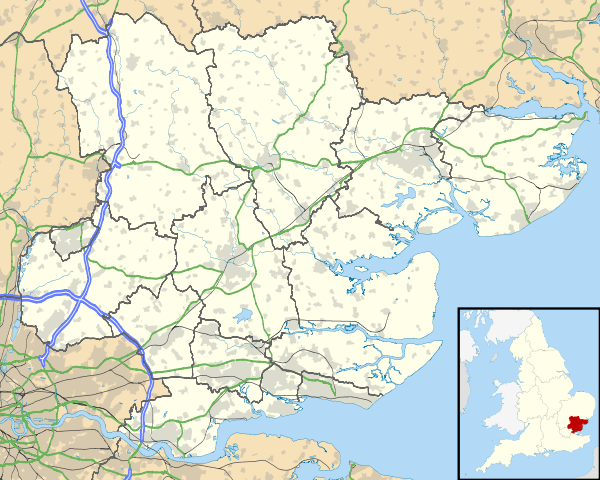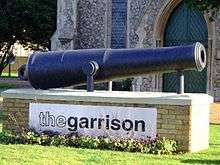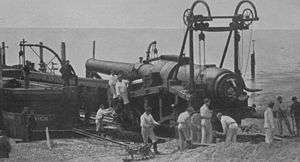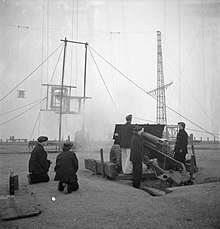MoD Shoeburyness
MoD Shoeburyness is a military installation at Pig's Bay near Shoeburyness in Essex.
| MoD Shoeburyness | |
|---|---|
| Shoeburyness, Essex | |
 Clock tower at Horseshoe Barracks, Shoeburyness | |
 MoD Shoeburyness | |
| Coordinates | 51.53710°N 0.80741°E |
| Type | Firing Range |
| Site information | |
| Open to the public | Yes |
| Site history | |
| Built | 1849 |
| In use | 1849–1976 |
History

In 1849, the Board of Ordnance purchased land at South Shoebury with a view to setting up an artillery testing and practice range (until then, Plumstead Common and Woolwich Common had been used, but these were no longer viable due to the increasing power and range of the weapons.)[1]
The 'Old Ranges'
Initially, the range was only used in the summer, but its use grew significantly during the Crimean War and from 1854 it was established as a permanent station. The officers' mess was set up in a former Coastguard station on what is now Mess Road, facing the sea; officers were accommodated in the terrace of coastguard cottages, to which a library and dining room were added in 1852. A simple 'hut barracks' was also built on the seafront, to the north-east (on what is now Parade Walk); and in 1856 a garrison hospital was established nearby. The ranges and practice areas were laid out to the west.[1]
RA School of Gunnery

In the wake of the Crimean War, the Royal Artillery School of Gunnery was established at Shoeburyness in 1859 'for individual improvement as well as for the advancement of artillery science in general'.[2] Horseshoe Barracks and various other amenities were added not long afterwards and the site was extended to cover some 200 acres lying between Ness Road and the coast.[1]
Over the years that followed Shoeburyness was integral to the development of new and improved artillery weapons.[3] Alongside its use as a training facility, the ranges were used for experimental trials of guns, rockets and explosives and for the testing of armour and defensive works.[1] As the scale of these experiments began to outgrow the site, its gun emplacements were adapted for seaward firing and it later specialized in coastal artillery training.[2]
.jpg)
An accidental explosion in February 1885 killed seven Royal Artillery personnel including the Commandant and his deputy.[4]
After 1889, experimentation and testing was progressively moved on to 'New Ranges' to the north-east, but the 'Old Ranges' remained in active use as a training area.[1]
The 'New Ranges'
As early as 1865 the Ordnance Select Committee was recommending the purchase of additional land at Shoeburyness, to accommodate the increasing power and range of artillery then in development. In due course land was acquired to the north-east, and from 1889 the establishment expanded on to a 'New Range', which encompassed Foulness and Havengore.[1]
Proof and Experimental Establishment

The Experimental Branch (part of the School of Gunnery since 1859) became an independent operation in 1905 (it was renamed the Experimental Establishment in 1920, and the Proof and Experimental Establishment (P&EE) in 1948, before becoming part of the Defence Test and Evaluation Organisation (DTEO) in 1995).[5]
The Coast Artillery School
In 1920 the School of Gunnery was redesignated as the 'Coast Artillery School' of the Royal Garrison Artillery, following the move of the Field Artillery and Horse Artillery equivalents to a new establishment (the School of Instruction for Royal Horse and Field Artillery) at Larkhill. In 1940 the Coast Artillery School was moved from Shoebury to Llandudno,[6] where it remained for the rest of the Second World War, before relocating to Plymouth.[7]
Shoebury Garrison

After the war, artillery and other regiments continued to be garrisoned at Shoebury until 1976 when the garrison headquarters closed. At the same time, the number of military personnel on the staff of the P&EE was reduced, especially in the 1980s, as civilian contractors increasingly took over the running of the Establishment.[1]
Following the closure of the Old Ranges in 1998 the old garrison land and buildings were sold and converted for housing.[3] The New Ranges remain in use, however; the work of the Experimental Establishment, begun in 1859, continues today under the auspices of Qinetiq. The site is known as MoD Shoeburyness.[3]
Present-day use
.jpg)
Active military site
Qinetiq manages the site on behalf of the Ministry of Defence and "provides defence Test and Evaluation (T & E), and training support services which help ensure the safety and effectiveness of munitions and skills used by the UK Armed Services".[8] In particular, the site provides a closed and controlled environment for testing weapons systems at various stages of development, for safe disposal of expired ammunition and for live-ammunition training in Explosive Ordnance Disposal techniques.[8]
Former military site
Several buildings and structures on the site are listed; together they are described by Historic England as constituting "a complete mid-19th century barracks".[9] As of 2016 many of these have been refurbished for sale as private houses, and additional housing is being built in the vicinity. A tower was planned to stand in the Shoeburyness Garrison housing development. The tower was to be 18 storeys high and designed to mark the start of the Thames Gateway development.[10]
Gallery
.jpg) Commandant's House (1851)
Commandant's House (1851) Accommodation range (1898) linked to Officers' Mess (1852), Mess Road
Accommodation range (1898) linked to Officers' Mess (1852), Mess Road.jpg) Officers' Mess: dining room (1852, extended 1898)
Officers' Mess: dining room (1852, extended 1898).jpg) Powder Magazines (1852–3)
Powder Magazines (1852–3).jpg) Beach House, Mess Road (1856); built for the second-in-command
Beach House, Mess Road (1856); built for the second-in-command.jpg) Garrison Hospital, Hospital Road (1856)
Garrison Hospital, Hospital Road (1856).jpg) Offices and Guard House flanking the clock tower (1856)
Offices and Guard House flanking the clock tower (1856)_(geograph_5857593).jpg) One of the eight barracks blocks around Horseshoe Crescent (1859)
One of the eight barracks blocks around Horseshoe Crescent (1859) Gunnery drill shed, Chapel Road (1859)
Gunnery drill shed, Chapel Road (1859).jpg) Single Officers' Quarters, Warrior Square Road (1860)
Single Officers' Quarters, Warrior Square Road (1860).jpg) Clerk of Works House, Warrior Square Road (1861)
Clerk of Works House, Warrior Square Road (1861).jpg) Married Officers' Quarters, The Terrace (1861–2)
Married Officers' Quarters, The Terrace (1861–2).jpg) Surgeon's House, The Terrace (1861–2; with Instructor's House added in 1871)
Surgeon's House, The Terrace (1861–2; with Instructor's House added in 1871) Sergeants' accommodation, Hospital Road (1861)
Sergeants' accommodation, Hospital Road (1861) Garrison Church of St Peter and St Paul (1866)
Garrison Church of St Peter and St Paul (1866).jpg) Long Course Officers' Quarters, Chapel Road (1871)
Long Course Officers' Quarters, Chapel Road (1871)_-_geograph.org.uk_-_317239.jpg) Light Quick Firing Battery (1872)
Light Quick Firing Battery (1872).jpg) Sergeants' Married Quarters, Thorpe Green Mews (1886)
Sergeants' Married Quarters, Thorpe Green Mews (1886)_-_geograph.org.uk_-_317535.jpg) Heavy Quick Firing Battery (1898)
Heavy Quick Firing Battery (1898)
References
- "A History of Shoebury Garrison". Southend Council. Retrieved 12 March 2016.
- Skentlebery, Norman (1975). Arrows to atom bombs: a history of the Ordnance Board. London: Ordnance Board.
- "MOD Shoeburyness". Qinetiq. Retrieved 12 March 2016.
- Glennie, p. 24-25
- Historic England. "Proof and Experimental Establishment, Shoeburyness Garrison, Old ranges, heavy quick-firing battery (1112693)". National Heritage List for England.
- "Trwynygogarth Gunnery Range, Great Orme's Head; Former Royal Artillery Coast Artillery School". Coflein. Retrieved 20 June 2019.
- Maurice-Jones, Colonel K. W. (2009). The History of Coast Artillery in the British Army. Naval and Military Press. p. 276. ISBN 978-1845740313.
- "Our work at MOD Shoeburyness". QinetiQ. Retrieved 9 December 2017.
- "Blocks K-M, Shoebury Garrison". Historic England. Retrieved 2 August 2016.
- "Thames Gateway – A new landmark for Shoebury?". BBC. Retrieved 12 March 2016.
Sources
- Glennie, D (1948). Gunners' Town. Civic Publications.